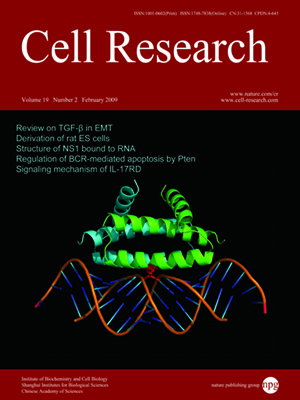Volume 19 Issue 2, February 2009: 208-215
ORIGINAL ARTICLES
IL-17RD (Sef or IL-17RLM) interacts with IL-17 receptor and mediates IL-17 signaling
Zhili Rong1, Anan Wang2, Zhiyong Li1, Yongming Ren1, Long Cheng1, Yinghua Li1, Yinyin Wang1, Fangli Ren1, Xiaoning Zhang1, Jim Hu2 and Zhijie Chang1
1School of Medicine, Department of Biological Sciences and Biotechnology, State Key Laboratory of Biomembrane and Membrane Biotechnology, Tsinghua University, Beijing 100084, China
2Department of Laboratory Medicine and Pathobiology, Physiology and Experimental Medicine, Hospital for Sick Children Research Institute, University of Toronto, Toronto, Canada M5G 1X8
Correspondence: Zhijie Chang,(zhijiec@tsinghua.edu.cn )
Interleukin-17 (IL-17 or IL-17A) production
is a hallmark of T
H17 cells, a new unique lineage of
CD4
+ T lymphocytes contributing to the pathogenesis of
multiple autoimmune and inflammatory diseases. IL-17 receptor (IL-17R
or IL-17RA) is essential for IL-17 biological activity. Emerging data
suggest that the formation of a heteromeric and/or homomeric receptor
complex is required for IL-17 signaling. Here we show that the orphan
receptor IL-17RD (Sef, similar expression to FGF genes or IL-17RLM) is
associated and colocalized with IL-17R. Importantly, IL-17RD mediates
IL-17 signaling, as evaluated using a luciferase reporter driven by
the native promoter of
24p3, an IL-17 target gene. In addition,
an IL-17RD mutant lacking the intracellular domain dominant-negatively
suppresses IL-17R-mediated IL-17 signaling. Moreover, IL-17RD as well
as IL-17R is associated with TRAF6, an IL-17R downstream molecule.
These results indicate that IL-17RD is a part of the IL-17 receptor
signaling complex, therefore providing novel evidence for IL-17
signaling through a heteromeric and/or homomeric receptor complex.
Cell Research (2009) 19:208-215. doi: 10.1038/cr.2008.320; published online 16 December 2008
FULL TEXT | PDF
Browse 1962


